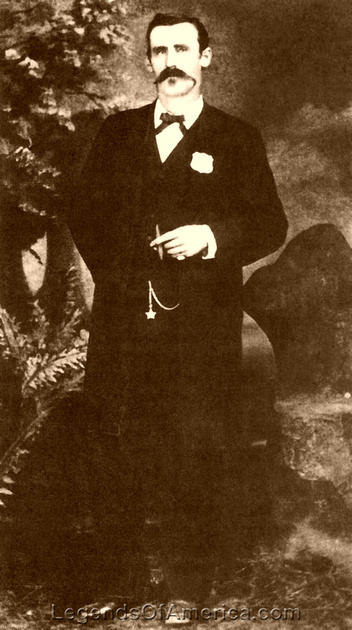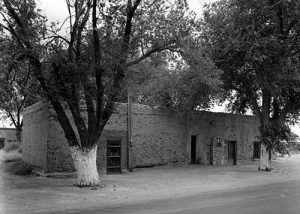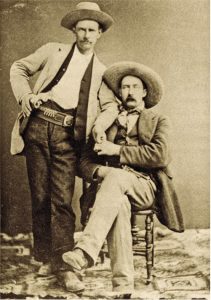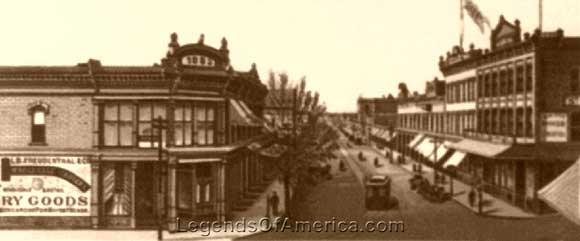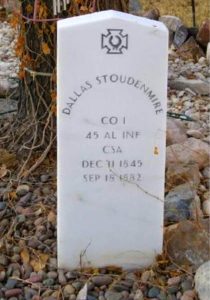Dallas Stoudenmire – Taming El Paso, Texas – Legends of America (original) (raw)
Dallas Stoudenmire (1845–1882)
A gunfighter and lawman, Dallas Stoudenmire was involved in more gunfights than most of his better-known counterparts and successfully tamed one of the most violent towns in the Old West.
Stoudemire was born in Aberfoil, Alabama, on December 11, 1845, one of nine children born to Lewis and Elizabeth Stoudenmire. In 1862, he joined the Confederate Army serving in the 45th Alabama Infantry, during which he was wounded several times and carried two bullets with him for the rest of his life.
When the war was over, he moved on to Columbus, Texas, around 1867, where he was said to have killed several men. Though dangerous, the 6’4″ man was said to have been quite a gentleman around the ladies, who found his handsome face and sharp dress quite attractive. However, Dallas had a nasty temper, especially when intoxicated. Continuing to hone his shooting skills, he became equally accurate with both hands and always wore two guns. During these years, he worked variously as a sheep farmer, carpenter, wheelwright, and merchandiser.
Sometime later, Dallas joined the Texas Rangers and, in 1874, was serving as a second sergeant in J. R. Waller’s company. Afterward, he lived briefly in the Texas Panhandle in Mexico during the days of Maximilian and served a short stint as a marshal in Socorro, New Mexico.
While in Socorro, his brother-in-law, “Doc” Cummings, who lived in El Paso, Texas, convinced him to come there and take up the marshal’s position. At the time, El Paso had a reputation as a violent town, and the city hoped to bring in someone from the “outside” who had a reputation as “tough” as the town. Stoudenmire fit the bill. In early April 1881, Stoudenmire traveled to El Paso and was hired almost immediately, starting his new position on April 11. He was the sixth town marshal in just eight months.
El Paso, Texas jail
His first task was to get the city jail keys from a deputy marshal who just happened to be the town drunk. When Stoudenmire approached the drunken deputy, Bill Johnson, to get the keys, Johnson mumbled that he would go home and figure out which ones they were. However, Stoudenmire became impatient, demanding the keys immediately. When Johnson continued to delay, Dallas physically turned the man upside down, took the keys, and threw him to the ground. Stoudenmire wasted no time living up to his formidable reputation and humiliating Johnson.
Just three days later, he was involved in one of the most famous gunfights in Texas, the “Four Dead in Five Seconds” gunfight. On April 14, 1881, while Constable Krempkau was in Keating’s Saloon, one of the worst pestholes in El Paso, Texas, he got into an argument with ex-City Marshal George Campbell. Also in the saloon was one of Campbell’s friends, John Hale. Hale, who was drunk and unarmed, pulled one of Campbell’s two pistols, shouting, “George, I’ve got you covered!” Hale then shot Krempkau, who fell wounded against the saloon door. Realizing what he had done, Hale ran behind a post in front of the saloon just as Marshal Dallas Stoudenmire appeared with his pistols raised.
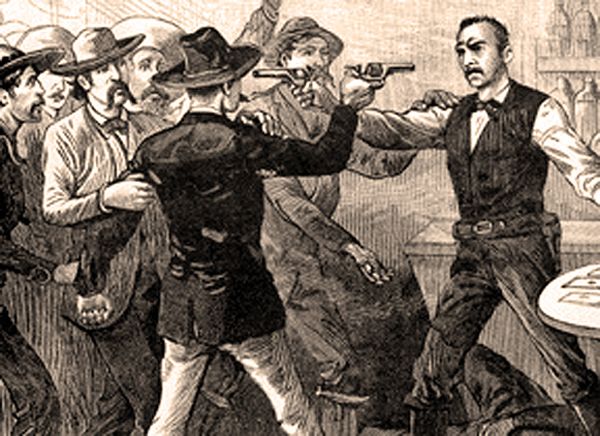
Saloon Gunfight
Stoudenmire then shot once, but the bullet went wild, hitting an innocent Mexican bystander. When Hale peeked out from behind the post, Stoudenmire fired again, hitting Hale between his eyes and killing him instantly. In the meantime, when Campbell saw Hale go down, he exited the saloon, waving his gun and yelling, “Gentlemen, this is not my fight!” However, the wounded Krempkau disagreed and fired at Campbell, striking him in the wrist and the toe. At the same time, Stoudenmire whirled and also fired on Campbell, pumping three bullets into his stomach. As Campbell crashed to the dusty street, he shouted, “You s.o.b., you have murdered me!” When the dust cleared, both George Campbell and Constable Kremkau lay dead. Four men lay dead in less than five seconds in a near-comic opera gun battle. This gunfight was well-publicized in newspapers in cities as far away as San Francisco and New York City and made Stoudenmire a legend.
George W. Campbell, standing next to Jim Manning in 1881
Just three more days later, on April 17, violence would erupt again when the wealthy Manning brothers, who were friends of Hale and Campbell, convinced a drunken Bill Johnson to assassinate Stoudenmire. However, it took little convincing on Johnson’s part as he was still suffering the humiliation he had felt at Stoudenmire’s hands less than a week past. Johnson then hid behind a large pillar of bricks with his shotgun and waited. A short time later, he heard the voices of Stoudenmire and his brother-in-law, Stanley “Doc” Cummings. As he started to aim, the drunken fool fell instead, accidentally firing two harmless blasts into the air. The marshal wasted no time returning fire, sending several bullets his way and leaving Johnson dead on the dusty street.
This, of course, further enraged the Manning brothers, who would eventually take their revenge. In the meantime, Stoudenmire continued to take a hard line against the lawless city of El Paso. Between the April shooting of Johnson and the following February, Dallas killed another six men in shootouts during arrest situations. As Stoudenmire’s legend grew, the city’s violent crime rate began to drop.
In February 1882, Dallas briefly returned to Columbus, Texas, to marry Isabella Sherrington. During his absence, on February 14, James Manning killed Stoudenmire’s brother-in-law and good friend, Stanley “Doc” Cummings. While Manning and Cummings were in the Coliseum Saloon, owned by Manning, the pair began to argue. The dispute escalated until gun smoke filled the room. When the air cleared, Cummings had stumbled outside the saloon door where he had fallen dead. Manning was arrested but, at his trial, it was determined that he had acted in self-defense.
With a jury filled with local residents, many of whom were Mannings friends, Stoudenmire was enraged. Unfortunately, the only man who had been able to control the marshal’s temper was the now-dead Cummings. The angry Stoudenmire also began to drink heavily and often confronted those people that he felt were responsible for Manning’s acquittal. It became so bad that many people avoided coming into town or visiting the saloons for fear of running into him. Though he had proved his effectiveness as a lawman, his actions began to turn the locals away from him. He was also a newcomer in a town where the Mannings had many friends.
Street in El Paso, Texas, 1888
City officials tried to control Stoudenmire, his drinking, and his actions by passing a law making it illegal for officers of the law to drink publicly and subject to a fine if caught. However, Stoudenmire himself collected the fines, so the law failed, and Stoudenmire continued to drink. In the meantime, his actions became more and more confrontational and bizarre. Sometimes, he was known to use the St. Clement’s Church bell for target practice as he patrolled the streets, was suspected of spending unauthorized funds, and constantly argued with city officials. His list of enemies grew, including El Paso Times editor George Washington Carrico, who alleged that the city’s crime rate varied inversely with the sobriety of its marshal.
By May 27, 1882, the town had finally had enough, and the council announced they would fire the marshal. However, when Stoudenmire confronted them, drunk, and dared them to take his guns or his job, they backed down. However, two days later, a sober Stoudenmire resigned. He then began to run the Globe Restaurant, which formerly belonged to his brother-in-law, Doc Cummings. In July, he also accepted an appointment as a U.S. Deputy Marshal. This, however, did not stop him from using his gun to settle arguments, and his ongoing feud with the Manning brothers continued.
The feud ran so deep that residents prevailed upon Stoudenmire and the Mannings to sign a “peace treaty” published in the El Paso Herald. But, Dallas continued to make threats every time he was drinking.
Dallas Stoudenmire’s Grave
On September 18, 1882, Stoudenmire and the Manning brothers – Doc, Frank, and Jim, met again in one of Manning’s saloons to sign another “peace treaty.” However, Doc and Dallas soon began to argue about the first peace treaty, and before you know it, they both had pistols in their hands. Doc fired first, shattering Stoudenmire’s left arm and causing him to drop his gun. A second bullet hit Stoudenmire’s shirt pocket that was filled with papers. Though it didn’t break the skin, it knocked him backward into the saloon doors and out onto the street. Dallas, a two-handed shooter, pulled his other gun and shot Doc as he came through the door, hitting him in the arm. Jim Manning followed and fired two shots, one going wild and the other hitting Stoudenmire behind his left ear, killing him instantly. Though the former marshal was dead, an enraged Doc Manning proceeded to pistol-whip him with his own gun.
James and Doc Manning were arrested but were acquitted when the ruling was found to be self-defense.
Stoudenmire’s funeral was held at El Paso’s Masonic Lodge #130 before his wife shipped his body to Columbus, Texas, for burial. He was buried in the Alleyton, Texas cemetery.
The Mannings continued to live in El Paso, and soon their killing of Dallas Stoudenmire was all but forgotten.
During his life, Stoudenmire was involved in more gunfights than most of his better-known counterparts, such as Wyatt Earp, Bat Masterson, Elfego Baca, Luke Short, Doc Holliday, and John Selman. He is credited with successfully taming one of the most violent towns in the Old West.
© Kathy Alexander/Legends of America, updated November 2022.
Legends of America founder/editor Kathy Weiser-Alexander takes part in AHC’s television series “_American Lawmen_” in their episode “Dallas Stoudenmire: The Hero of El Paso,” original air date March 16, 2016.
Kathy Weiser Alexander on AHC’s American Lawmen discussing Dallas Stoudenmire
Also See:
Texas Rangers – Making Order Out of Chaos
